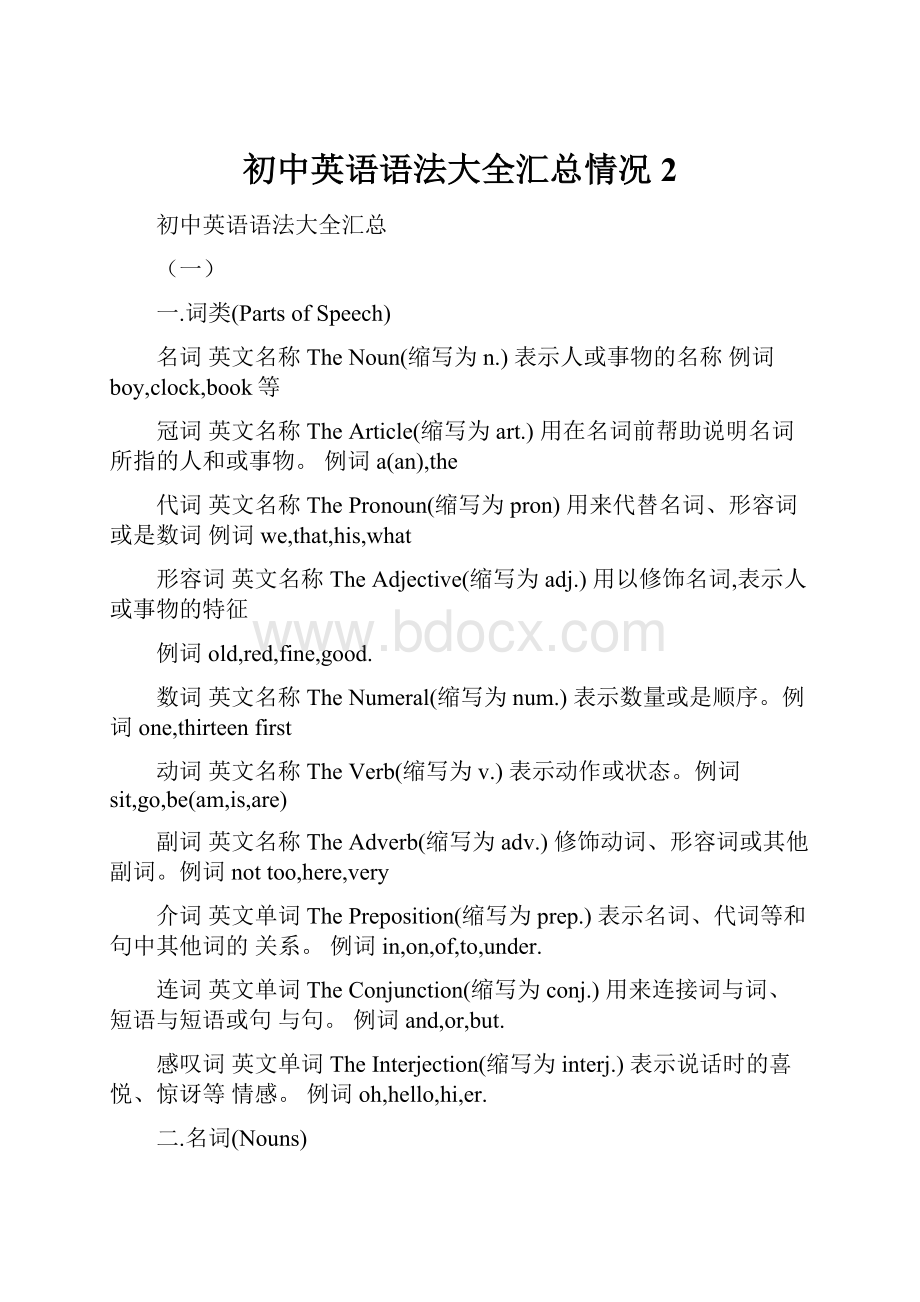初中英语语法大全汇总情况2.docx
《初中英语语法大全汇总情况2.docx》由会员分享,可在线阅读,更多相关《初中英语语法大全汇总情况2.docx(33页珍藏版)》请在冰豆网上搜索。

初中英语语法大全汇总情况2
初中英语语法大全汇总
(一)
一.词类(PartsofSpeech)
名词英文名称TheNoun(缩写为n.)表示人或事物的名称例词boy,clock,book等
冠词英文名称TheArticle(缩写为art.)用在名词前帮助说明名词所指的人和或事物。
例词a(an),the
代词英文名称ThePronoun(缩写为pron)用来代替名词、形容词或是数词例词we,that,his,what
形容词英文名称TheAdjective(缩写为adj.)用以修饰名词,表示人或事物的特征
例词old,red,fine,good.
数词英文名称TheNumeral(缩写为num.)表示数量或是顺序。
例词one,thirteenfirst
动词英文名称TheVerb(缩写为v.)表示动作或状态。
例词sit,go,be(am,is,are)
副词英文名称TheAdverb(缩写为adv.)修饰动词、形容词或其他副词。
例词nottoo,here,very
介词英文单词ThePreposition(缩写为prep.)表示名词、代词等和句中其他词的关系。
例词in,on,of,to,under.
连词英文单词TheConjunction(缩写为conj.)用来连接词与词、短语与短语或句与句。
例词and,or,but.
感叹词英文单词TheInterjection(缩写为interj.)表示说话时的喜悦、惊讶等情感。
例词oh,hello,hi,er.
二.名词(Nouns)
1.总的说来,名词分专有名词和普通名词两类。
专有名词:
表示具体的人,事物,地点或机构的专有名称。
LucyChina中国 Asia亚洲 Beijing北京。
专有名词的第一个字母要大写。
普通名词:
表示某些人,某类事物,某种物质或抽象概念的名称。
例如:
teacher老师 tea茶 reform改革
普通名词又可进一步分为四类
1)个体名称:
表示单个的人和事物。
house马 car汽车 room房间 apple苹果 fun风扇 picture照片
2)集体名称:
表示一群人或一些事物的名称。
people人们 family家庭 army军队 government政府group集团
3)物质名词:
表示物质或不具备确定形状和大小的个体的物质。
fire火 steel钢 air空气 water水 milk牛奶
4)抽象名词:
表示动作,状态,品质或其他抽象概念。
labour劳动 health健康 life生活 friendship友情 patience耐力
2.名词按其所表现的事物的性质分为可数名词和不可数名词。
可数名词(CountableNouns)有复数形式,如:
anappletwoapplesacarsomecars
不可数名词(UncountableNouns)一般没有复数形式.
抽象名词,物质名词和专有名词一般是不可数名词。
sand沙 sugar糖
有少数名词即可作可数名词,也可作不可数名词,但含义不同。
glass玻璃 glass玻璃杯 paper纸 paper报纸,文件
名词的功能
名词在句中作主语,宾语,介词宾语,宾语补助语,表语以及名词短语作状语。
Thebagisinthedesk.bag作主语。
书包在桌子里边。
Iwashedmyclothesyesterday.clothes作宾语。
昨天我洗了我的衣服。
Thisisagoodbook.book作表语。
这是一本好书。
Weelectedhimourmonitor.monitor作宾语补助语。
我们选他为我们的班长。
Maryliveswithherparents.parents作介词宾语.
玛丽和她的父母亲住在一起。
HeisaPartymember.Party作定语.
他是一名党员。
Theystudyharddayandnight.dayandnight作状语。
他们白天黑夜地学习。
3.可数名词有单数(theSingularNunmber)和复数(thePluralNumber)两种形式。
名词的复数形式(ThePluralFormNouns)的部分规则如下:
1)一般情况下,在词尾加-s.例如:
bags,maps,pens,desks,workers
2)以s,sh,ch,x等结尾的词加-es.
例如:
buseswatchesboxes
3)以ce,se,ze,(d)ge等结尾的词加-s.
例如:
licencesblousesoranges
4)以辅音字母+y结尾的词变y为i再加-es.
例如:
babiesfamilies
5)名词以-f或-fe结尾的,把-f或-fe变成-ves.
bookshelves,wives,knives
注:
英语中有些名词的复数形式是不规则的,需要一一记忆常见的有,
man-men woman-women foot-feet
tooth-teeth mouse-nice ox-oxen
sheep-sheep dear-dear fish-fish
英语中有些名词总是以复数形式出现。
scissors剪刀goods货物trousers裤子clothes衣服glasses玻璃杯
4.名词的所有格(ThePossessiveCaseofNouns)
在英语中,名词的格有三个,主格,宾格和所有格。
它们的形式及其变化表示与其他词的关系。
实际上,主格和宾格通过它在句中的作用和位置来确定。
Thebirdisinthetree.鸟在树上。
bird作主语,是主格。
Isawafilmyesterday.昨天我看了一场电影。
film作宾语,是宾格。
名词的所有格:
名词中表示所有关系的形式叫做名词所有格。
LuXun'sbookisworthreading.
鲁迅的书值得一读。
Thisismyfather'sroom.
这是我父亲的房间。
名词所有格的构成
单数名词加's例词:
Mike'sfather
以s结尾的复数名词加'例词:
theteachers'room
不以s结尾的复数名词加's例词:
men'swomen's
三、代词(Pronouns)
1.人称代词(PersonalPronouns)
第一人称单数主格I(复数We)单数宾格me(复数us)
第二人称单数主格you(复数you)单数宾格you(复数you)
第三人称单数主格he,she,it(复数they)单数宾格him,her,it(复数them)
2.物主代词(PossessivePronouns)
形容词性物主代词第一人称单数my(复数our)
形容词性物主代词第二人称单数your(复数your)
形容词性物主代词第三人称单数his,her,its(复数their)
名词性物主代词第一人称单数mine(复述ours)
名词性物主代词第二人称单数yours(复数yours)
名词性物主代词第三人称单数his,hers,its(复数theirs)
四、数词(Numeral)
表示数目多少或顺序多少的词叫数词,数词分为基数词和序数词。
表示数目多少的数词叫基数词;表示顺序的数词叫序数词。
基数词(CardinalNumbers)
1one2two3three4four5five6six
11eleven12twelve13thirteen20twenty
21twenty-one40fouty100onehundred
五、动词(Verb)
一般现在时(TheSimplePresentTense)
一般现在时表示现在的状态
如:
Heistwelve.Sheisathome.
表示经常的或是习惯性的动作.
如:
Igotoschoolat7:
30everyday.
表示主语具备的的性格和能力等
如:
Shelikeapple.TheyknowEnglish.
1.动词be(Verbtobe)
肯定式Iam......否定Iamnot....
肯定式Youare...否定式Youarenot....
肯定式He/She/Itis....否定式He/She/Itisnot....
疑问句和简略答语
AmI....?
Yes,youare./No,Iyouarenot.
Areyou....?
Yes,Iam./No,Iamnot.
2.Therebe结构
"Thereis/are+某物/某人+某地/某时"这样一种句型,大致相当于汉语
"某地/某时有某物/某人"的说法.句子的is/are和后面所跟的名词在数
方面必须是一致.
肯定式:
Thereis(There's)atableinyourroom.
Thereare(There're)somepencilsonthedesk.
否定式:
Thereisnot(Thereisn't)anycatshere.
Therearenot(aren't)anycatshere.
疑问式和简略答语
Istherearulerinyourbag?
Yes,thereis./No,thereisnot(isn't).
Arethereanypeopleinthathouse?
Yes,thereare./No,therearenot(aren't).
Howmanykitesarethereinthesky?
Therearethirteen.
六、介词(Prepositions)
介词一般用于名词或代词前,表示该词与句子其他成分的关系.介词后面的名词
或代词称为介词宾语.介词和介词宾语一起构成介词短语.
本册课本出现的介词短语如下:
at:
athomeatschoolatsixthirty
behind:
behindthedoor/treebehindone'schair
beside:
besidethedoorbesidethehouse
from:
fromonetoahundred
in:
inRow/Team/Class/Grade4
inone'sschool/grade/class/team/rom
inyourdesk/pencil-box/bedroom
inthepictureinthesameclassindifferentclasses
inEnglishinthehatinthemorning/afternoon
like:
likethis/that
near:
nearthewindownearthedoor
of:
apictureofaclassroomamapofChina
thenameofhercatthewalloftheirclassroon
on:
onthedesk/chairontheflooronthewallonthebike
ontheduty
to:
(aquarter)toten(go)toschool/bed/work
under:
underthedesk/tableunderthetree/windowunderone'schair/bed
(1) 表示时间:
at:
表示某一时间点
如:
atnoon
on:
表示特定的日子
如:
onChristmas
in:
表示一段不具体的时间
如:
inthemorning,intheSecondworldwar
如表示在某一特定的早上、下午则用on
如:
onacoldmorning,onahotafternoon,onSundaymorning
during:
表示期间内的某个时期
如:
duringthenight,duringtheSecondWorldWar
for:
其后接表示一段时间长度的词
如:
forthreedays
through:
表示在整个期间没有间歇
例:
Itsnowedthroughthenight.
till/until:
表示动作持续的终点
例:
Istudiedhardtilltwelveo'clocklastnight.
by:
表示动作完成期限
例:
I'llbebackbyfiveo'clock.
since:
表示某动作的起始点
例:
IhavestudiedEnglishsince1990.
(2)表示地点:
at:
表示较小的地点
如:
arrivedattheschoolgate
in:
表示较大的地点
如:
arrivedinShanghai
for:
表示目的地
例:
I'llleaveforShanghai.
above:
表示上面,上方,其反意词是below
over:
表示垂直上方,其反意词是under
例:
Thedogjumpedoverthetable.
through:
表示穿过
如:
throughtheforest
across:
表示平原上的跨越
例:
Iwanttowalkacrosstheroad.
七、句子的种类(KindsofSentences)
英语的句子按照用途可分为以下四类:
陈述句用途是用来说明事实或说话人的看法例句:
Icanseeamaponthewall.
Ithinkit'shis.
疑问句用途是用来提出问题.例句:
AreyouMrGreen?
Canyoufindit?
Howoldareyou?
祈使句用途是用来表示请求和命令.例句:
Sstandup.Comein,please.
Let'splaygames.
感叹句用途是用来表达强烈的感情.例句:
Whatafinedayitis!
Howbeautifultheflowersare!
八、一般疑问句和特殊疑问句
一般疑问句子和特殊疑问句
一般疑问句(GeneralQuestion)一般是指用Yes或No回答的疑问句。
例如:
Issheatschooltoday?
Yes,sheis/No,sheisn't.
Canyouseeapencileonthedesk?
Yes,Ican./No,Ican't.
Doyouplayfootball?
Yes,theydo./No,theydon't.
特殊疑问句是以特殊疑问词开头的疑问句.
(二)
一.形容词和副词的比较级和最高级
(TheComparativeandSuperlativeDegreesofAdjectiveandAdverbs)
大多数形容词和副词有三个等级:
1)原级,即原形。
2)比较级,表示“较……”或“更……一些”的意思。
3)最高级,表示“最……”的意思。
1.形容词和副词比较级和最高级的构成
(1)规则变化
单音节词和少数双音节词
一般在词尾加-er或-est
coldcoldercoldest
strongstrongerstrongest
fastfasterfastest
slowslowslowest
以字母e结尾的形容词,加-r或-st
nicenicernicest
largelargerlargest
重读闭音节词只有一个辅音字母时,应先双写辅音字母,再加-er或-est
bigbiggerbiggest
thinthinnerthinnest
hothotterhottest
以“辅音字母+y”结尾的双音节词,先改“y”为“i”,再加-er或-est
easyesaiereasiest
happyhappierhappiest
earlyearlierearliest
少数以-er,-ow 结尾的双音节词clever(聪明的)未尾加-er,-est
clevercleverercleverest
narrow narrowernarrowest
多音节词和部分双音节词
在词前加more或most
deliciousmoredeliciousmostdelicious
interestingmoreinterestingmostinterting
easilymoreeasilymosteasily
carefullymorecarefullymostcarefully
(2)不规则变化
good/well better best
bad/badly worse worst
much/many more most
little less least
far farther/further farthest/furthest
2.形容词和副词的比较级和最高级的用法
比较级:
表示两者(人或事物)的比较
MrKingistallerthanMrRead
Thismooncakesisnicerthanthatone。
Thetractorisgoingfasterthanthebike。
最高级:
表示三者或三者以上(人或事物)的比较,其中有一个在某一方面超过
其他几个时,用最高级。
最高级的前面一般要加定冠词the。
后面可带of(in)
短语来说明比较的范围。
Whosedrawingishebestofall?
Sheistheyoungestintheclass.
Thetaxiisgoingghefastest.
MrQiniswalkingtjeslowestofall.
注:
在形容词和副词的比较级前,有时可以用much,alittle等来修饰,
如:
muchbetteralittletaller
二。
数词(Numerals)
(2)
序数词(OrdinalNumbers)
序数词表示事物的顺序,往往与定冠词the连用。
fist1sttwentieth20th
second2ndtwenty-first21th
third3ndthirieth30th
fourth4ndthirty-ninth39th
fifth5ndfortieth40th
sixth6thfiftieth50th
seventh7thsixtieth60th
eighth8thseventieth70th
nineth9thninetieth80th
tenth10thhundredth100th
eleventh11thonehundredandfirst101st
twelfth12th
三、冠词(Articles)
冠词是一种虚词,让在名词的前面,帮助说明名词的含义,
冠词分不定冠词(TheIndefiniteArticle)
和定冠词(TheDefineArticle)两种,a(an)是不定冠词。
a用在辅音之前,如:
aroad
aboy;an用在元音之前,如:
anhour;anoldman等;the是定冠词。
1.不定冠词的用法
用于可数名词的单数形式前,指人或事物的某一种类。
Susanisascientist.
Passmeanorange,please.
指某人或某事,但不具体说明何人或何物。
Aboyislookingforyou。
Weworkfivedaysaweek。
表示“一”这个数量,但数的概念没有one强烈。
WearegoingtohaveanEnglishlessontomorrow。
Ihaveamouth,anose,twoeyesandtwoears。
用于某些固定的词组中。
afew,alittle,alotof,amomentago
2.定冠词的用法。
特指某些人或某些事物
Showmethephotooftheboy。
Thebookonthedeskismine。
指双方都知道的人或事物。
Wherearethenewbooks,Jim?
Theyareonthesmalltable。
指上文提过的人或事物。
JiMeilivesonafarm。
Thefarmisnotbig。
用在世界上独一无二的事物前。
Thesunisbiggerthanthemoon。
用在序数词和形容词最高级前。
ThefirstmonthoftheyearisJanuary。
Walkalongthisroad,andtakethefourthturningontheleft。
用在由普通名词构成的专有名词前。
theGreatWall
theWomen'sHospital
用在一些习惯用语中。
inthemorning(afternoon,evening),
ontheleft(right),attheback(front)of
thedaybefoeryeste